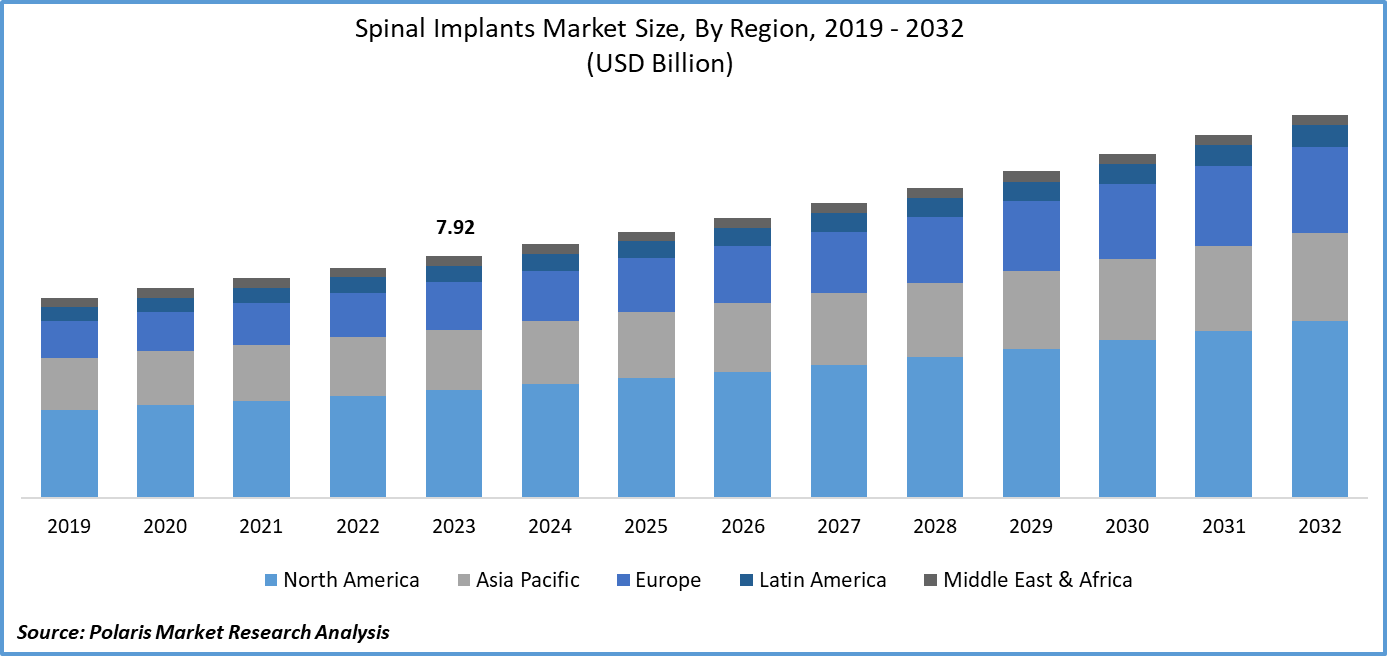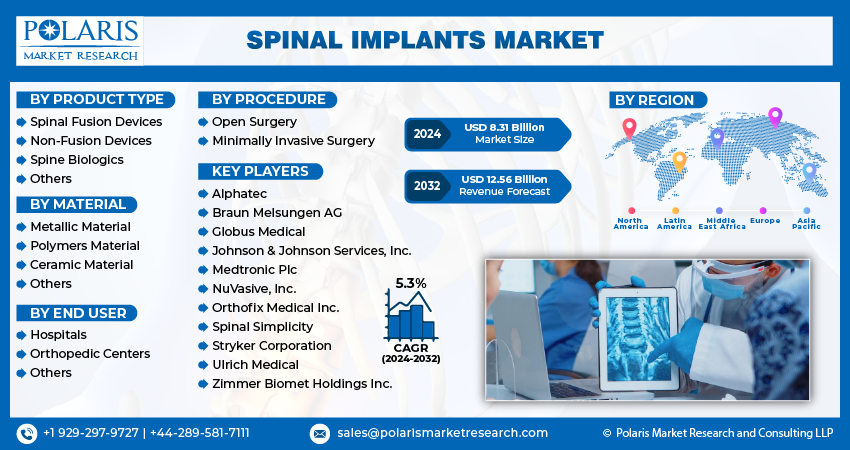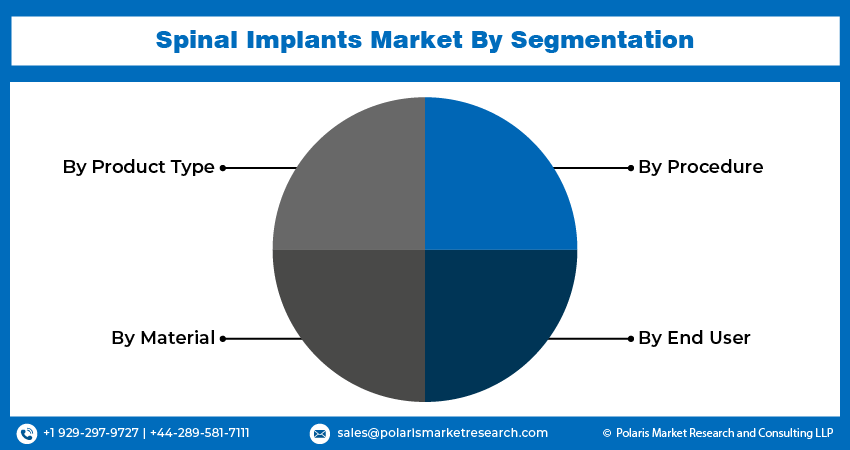
Spinal Implants Market Share, Size, Trends, Industry Analysis Report, By Product Type (Spinal Fusion Devices, Non-Fusion Devices, Spine Biologics, Others); By Material; By Procedure; By End User; By Region; Segment Forecast, 2024 - 2032
- Published Date:Jan-2024
- Pages: 116
- Format: PDF
- Report ID: PM4465
- Base Year: 2023
- Historical Data: 2019 – 2022
Report Outlook
Global spinal implants market size was valued at USD 7.92 billion in 2023. The market is anticipated to grow from USD 8.31 billion in 2024 to USD 12.56 billion by 2032, exhibiting a CAGR of 5.3% during the forecast period.
Industry Trends
Spinal implants are medical devices used to stabilize and support the spine in cases where there has been damage or degeneration of the vertebrae, discs, or surrounding tissue. These implants are made of various materials such as metal, polymers, or ceramics and come in different shapes and sizes depending on their intended use. They are surgically placed into the body and can be used to fuse two or more vertebrae (fusion), replace a damaged disc (arthroplasty), or provide temporary stability.
The global spinal implants market outlook is a rapidly growing industry, driven by increasing incidences of spinal disorders and advancements in technology. The increasing prevalence of spinal diseases such as degenerative disc disease, scoliosis, and spondylolisthesis are major drivers of the market. In addition, the rising geriatric population, who are more susceptible to spinal disorders, is also contributing to the growth of the market. In parallel, advancements in technologies such as minimally invasive surgery and motion preservation devices have increased the demand for spinal implants.
For instance, in November 2023, Spinal Elements launched the Ventana 3D-Printed Interbody Portfolio, featuring innovative design maximizing bone graft volume and providing clear radiographic visualization for spinal fusion procedures.
However, the high cost of these procedures and the need for reimbursement in some countries may hinder the growth of the market. Moreover, the risk of complications associated with spinal surgeries and the availability of alternative treatments such as physiotherapy and pain management medications may also restrain the market's growth. Despite these challenges, the spinal implants industry trends are expected to showcase positive growth due to the increasing awareness about spine health and the development of innovative products that cater to patient needs.

To Understand More About this Research: Request a Free Sample Report
The market research report offers an in-depth analysis of the industry to support informed decision-making. It offers a meticulous breakdown of various market niches and keeps readers updated on the latest industry developments. Along with tracking Spinal Implants Market on the basis of SWOT and Porter’s Five Forces models, the research report includes graphs, tables, charts, and other pictorial representations to help readers understand the key insights and important data easily.
The report provides information on spinal implant market revenue and sales at the global, national, and regional levels. Besides, it includes a detailed segmentation of the market, primarily based on types, applications, end-uses, and regions. The segmentation helps businesses and stakeholders plan their products, finances, and business strategies by considering the upcoming development rate for every segment.
Key Takeaways
- North America dominated the market and contributed over 32% of the spinal implants market share in 2023
- By product type category, the spinal fusion devices segment held the largest spinal implants market share in 2023
- By material category, the metallic materials segment dominated the global spinal implants market size in 2023
- By procedure category, the minimally invasive surgery segment is expected to grow with a lucrative CAGR over the market forecast of 2032
- By end-user category, the hospitals segment was the dominating sector in terms of spinal implants market share in 2023
What are the Market Drivers Driving the Demand for Spinal Implants Market?
The Spinal Implants Industry Growth is Driven by the Increasing Prevalence of Spinal Disorders in Both Young as Well as Senior Population
The growing incidence of spinal disorders, such as degenerative disc disease, scoliosis, and spondylolisthesis, among both the young and elderly populations is a significant factor driving the expansion of the spinal implant market. As people age, their bones, muscles, and joints undergo wear and tear, which can lead to conditions that affect the spine, such as osteoporosis, herniated discs, and spinal stenosis. These conditions can cause chronic pain, reduced mobility, and decreased quality of life, leading many individuals to seek surgical interventions, including spinal implant procedures.
In parallel, younger individuals may require spinal implants due to injuries or congenital conditions, further contributing to the demand for these devices. The development of advanced technologies, such as minimally invasive techniques and biodegradable materials, has increased the adoption of spinal implants, providing patients with safer and more effective treatment options. This growing demand for spinal implants is expected to continue, driven by an aging population and advancements in medical technology, thereby fueling the growth of the global spinal implant market.

Which Factor is Restraining the Demand for Spinal Implants?
The High Cost of Procedures and Risk of Complications Hinders Market Growth
The cost of spinal implant surgery is usually expensive, especially for patients who do not have adequate insurance coverage or who live in countries with limited healthcare resources. In addition, the risk of complications associated with spinal implant surgery, such as infection, nerve damage, and blood clots, deters patients from undergoing the procedure. Furthermore, the development of new technologies and techniques that reduce the invasiveness and cost of spinal implant procedures may not be accessible to all patients, particularly those in low-income regions, further limiting the market's growth. Therefore, addressing these challenges is crucial to increasing accessibility and expanding the global market.
Report Segmentation
The market is primarily segmented based on product type, material, procedure, end user, and region.
|
By Product Type |
By Material |
By Procedure |
By End User |
By Region |
|
|
|
|
|
To Understand the Scope of this Report: Speak to Analyst
Category Wise Insights
By Product Type Insights
Based on product type analysis, the market is segmented on the basis of spinal fusion devices, non-fusion devices, spine biologics, and others. The spinal fusion devices anticipated the largest spinal implants market size in 2023 since spinal fusion surgeries are commonly performed to treat various spinal conditions such as degenerative disc disease, spondylolisthesis, and fractures. These surgeries involve the use of spinal fusion devices, which help stabilize and align the spine, promoting bone growth and healing. Also, advancements in technology have led to the development of innovative fusion devices, such as motion-preserving devices and minimally invasive, which have increased their adoption rate among orthopedic surgeons. Further, the aging population and increasing prevalence of spinal disorders also contribute to the high demand for spinal fusion devices, contributing to the dominance of this segment.
By Material Insights
Based on material analysis, the market has been segmented on the basis of polymers material, metallic materials, ceramic materials, and others. The metallic material segment dominated the market for spinal implants market share due to its strength, durability, and biocompatibility properties. Metals such as titanium and stainless steel are widely used in spinal implant devices because they offer excellent resistance to corrosion, fatigue, and wear, which are essential for long-term clinical performance. In addition, metal implants can be designed to mimic the natural shape and structure of bone, allowing for better integration with surrounding tissue and enhanced stability.
Further, metallic materials have been extensively studied and tested for their safety and efficacy in spinal implant applications, making them a tried and trusted option for surgeons and patients alike. Also, the use of advanced manufacturing techniques such as 3D printing has enabled the production of complex geometries and customized implants that can be tailored to individual patient needs, further contributing to the dominance of metallic materials in spinal implants.
By Procedure Insights
Based on procedure analysis, the market has been segmented on the basis of open surgery and minimally invasive surgery. The minimally invasive surgery segment is expected to register a significant CAGR over the forecast period in the market since minimally invasive surgeries are associated with less tissue damage, reduced blood loss, and faster recovery times compared to traditional open surgeries. This has led to an increasing preference for minimally invasive procedures among patients and surgeons, driving the demand for spinal implants that can be used in these surgeries.
In parallel, advancements in technology have made it possible to perform complex spinal procedures through minimal incisions, further expanding the scope of minimally invasive spine surgery. For instance, in September 2021, Medtronic Plc, a major player in the field of medical technology, unveiled new offerings: Catalyft PL and PL40, Space-D Access System, and Accelerate Graft Delivery System for its minimally invasive spine surgery ecosystem. The latest addition combines spinal implants, biologics, navigation, robotics, and AI-powered data to provide advanced solutions for both surgeons and patients.
As a result, there is a growing need for spinal implants that can be used in minimally invasive procedures, such as interspinous process spacers, transforaminal lumbar interbody fusion devices, and posterior cervical stabilization systems. This trend is expected to continue during the forecast period, contributing to the growth of the minimally invasive surgery segment in the market.

Regional Insights
North America
North America emerged as the largest region in terms of spinal implants market size in 2023 due to the increasing prevalence of spinal disorders and injuries in the region, which has led to a growing demand for advanced spinal implant technologies. The National Spinal Cord Injury Statistical Center reports an annual incidence of around 54 cases of spinal cord injury per one million people in the United States, leading to approximately 17,500 new SCI cases each year. The presence of well-established healthcare infrastructure, high healthcare expenditure, and favorable reimbursement policies have contributed to the growth of the spinal implant market in North America. Also, the region is home to many prominent players in the spinal implant industry, which has fueled innovation and advancements in technology, leading to increased adoption rates among patients and healthcare professionals.
Europe
The European region is expected to witness substantial growth in the market over the forecast period due to the increasing prevalence of spinal disorders and degenerative diseases, such as osteoporosis, scoliosis, and spondylolisthesis, which will drive the demand for spinal implants in the region. Also, the changing perception of patients about the benefits of spinal implants and the availability of advanced implant materials and designs will further boost the market's expansion in the region.

Competitive Landscape
The spinal implants market is highly competitive, with market key companies competing for market share. The prominent players in this market include Medtronic, Stryker, Globus Medical, and Alphatec. These companies are focusing on product innovation and expansion of their product portfolios to stay ahead of the competition. Key market companies in the spinal implant market are investing heavily in research and development to enhance their product offerings, thereby driving market growth. These players are also adopting various strategic measures to expand their global reach, such as entering into contractual agreements, increasing investments, pursuing mergers and acquisitions, and collaborating with other organizations.
Some of the major players operating in the global market include:
- Alphatec
- Braun Melsungen AG
- Globus Medical
- Johnson & Johnson Services, Inc.
- Medtronic Plc
- NuVasive, Inc.
- Orthofix Medical Inc.
- Spinal Simplicity
- Stryker Corporation
- Ulrich Medical
- Zimmer Biomet Holdings Inc.
Recent Developments
- In August 2023, Orthofix Medical announced the U.S. commercial launch for its 7D Flash which is a new spine surgery navigation system.
- In April 2022, Spinal Simplicity, a medical device company, announced the launch of the Minuteman G5 implant, which is a minimally invasive, interspinous-interlaminar fusion device.
- In October 2021, NuVasive, Inc. announced the launch of the Cohere TLIF-O implant, which is a porous PEEK implant for the transforaminal lumbar interbody fusion (TLIF) procedure with a variety of implant sizes.
Report Coverage
The spinal Implants market report emphasizes key regions across the globe to provide a better understanding of the product to the users. Also, the report provides market insights into recent developments and trends and analyzes the technologies that are gaining traction around the globe. Furthermore, the report covers an in-depth qualitative analysis pertaining to various paradigm shifts associated with the transformation of these solutions.
The report provides a detailed analysis of the market while focusing on various key aspects such as competitive analysis, product type, material, procedure, end user, and their futuristic growth opportunities.
Spinal Implants Market Report Scope
|
Report Attributes |
Details |
|
Market size value in 2024 |
USD 8.31 billion |
|
Revenue Forecast in 2032 |
USD 12.56 billion |
|
CAGR |
5.3% from 2024 – 2032 |
|
Base year |
2023 |
|
Historical data |
2019 – 2022 |
|
Forecast period |
2024 – 2032 |
|
Quantitative units |
Revenue in USD billion and CAGR from 2024 to 2032 |
|
Segments Covered |
By Product Type, By Material, By Procedure, By End User, By Region |
|
Regional scope |
North America, Europe, Asia Pacific, Latin America, Middle East & Africa |
|
Customization |
Report customization as per your requirements with respect to countries, regions, and segmentation. |
The analysis of the Spinal Implants Market extends to a comprehensive market forecast up to 2032, coupled with a retrospective examination. Avail yourself of a complimentary PDF download to sample this in-depth industry analysis.
Navigate through the intricacies of the 2024 spinal implants market with precision, thanks to the comprehensive statistics on market share, size, and revenue growth rate assembled by Polaris Market Research Industry Reports. This thorough analysis not only provides a glimpse into the historical context but also extends its reach with a market forecast outlook until 2032. Immerse yourself in the richness of this industry analysis by securing a complimentary PDF download of the sample report.
Browse Our Top Selling Reports
Packaged Salad Market Size, Share 2024 Research Report
Coworking Spaces Market Size, Share 2024 Research Report
Pessary Market Size, Share 2024 Research Report
High Altitude Platform Market Size, Share 2024 Research Report
FAQ's
key companies in Spinal Implants Market are Alpla Group, Amcor Plc, Amerplast Ltd., Berry Global, Comar, Diversey, Essity, Glenroy, JohnsByrne
Spinal Implants Market exhibiting the CAGR of 5.3% during the forecast period
The Spinal Implants Market report covering key segments are product type, material, procedure, end user, and region.
key driving factors in Spinal Implants Market are increasing prevalence of spinal disorders in both young as well as senior populations drives market growth
Spinal Implants Market Size Worth USD 12.56 Billion By 2032
